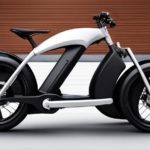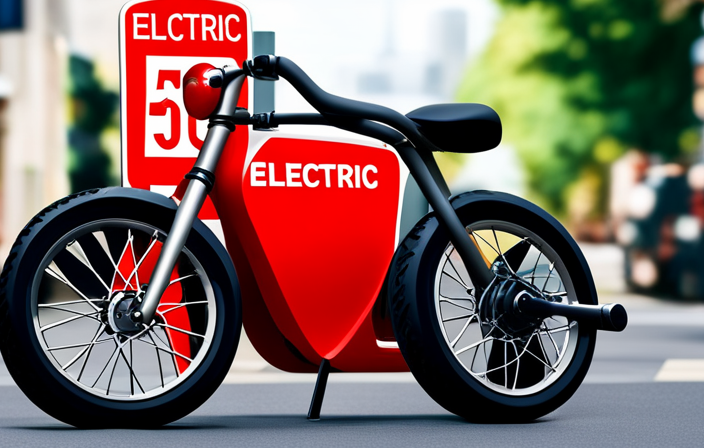Are you tired of your electric bike’s battery dying on you just as you’re about to reach your destination? Well, fear not! In this article, we will delve into the intriguing world of electric bike batteries and explore just how long they can last.
From the factors that affect battery life to tips for extending its longevity, we’ve got you covered.
So, sit back, relax, and let’s dive into the electrifying world of electric bike batteries!
Key Takeaways
- The battery life on an electric bike can be affected by various factors such as riding at high speeds, using higher pedal assist levels, riding on hilly terrains, and battling strong headwinds.
- Adjusting pedal assist levels based on the terrain and riding conditions can optimize battery efficiency.
- Regularly checking tire pressure and maintaining proper inflation levels can enhance battery efficiency.
- Minimizing weight on the e-bike by removing unnecessary accessories and reducing the load can improve battery range and overall riding experience.
Factors Affecting Battery Life
You’ll want to consider factors such as terrain, weight, and speed when determining how long your electric bike battery will last. These factors can greatly affect the overall battery life and performance.
Firstly, battery maintenance plays a crucial role in maximizing its lifespan. Regularly charging and storing the battery correctly can help maintain its capacity and efficiency.
Secondly, the battery capacity itself is an important factor to consider. Higher capacity batteries generally have a longer range and can support longer rides.
Additionally, the terrain you ride on and the weight of the rider can impact battery life. Riding on hilly terrain or carrying heavy loads may drain the battery more quickly.
Taking all these factors into account will give you a better understanding of how long your electric bike battery will last.
Moving on to the average lifespan of electric bike batteries, it is important to note that various factors can impact the longevity of a battery.
Average Lifespan of Electric Bike Batteries
Typically, the average lifespan of e-bike batteries is around 3 to 5 years. However, this can vary depending on several factors, including usage, charging habits, and battery quality. To ensure that your electric bike battery lasts as long as possible, here are some battery maintenance tips:
- Regularly charge your battery to prevent deep discharges.
- Avoid exposing your battery to extreme temperatures, as this can reduce its lifespan.
- Store your battery properly when not in use, ideally in a cool and dry place.
- Clean the battery terminals regularly to prevent corrosion.
When choosing the right battery for your electric bike, consider factors such as capacity, voltage, and compatibility with your bike’s motor. It’s important to select a battery that meets your specific needs and provides sufficient power for your desired range.
By following these battery maintenance tips and selecting the right battery, you can maximize the longevity of your electric bike battery.
Transitioning to the subsequent section about maximizing battery longevity, it’s important to also consider other factors that can impact the lifespan of your e-bike battery.
Maximizing Battery Longevity
To maximize the longevity of your electric bike battery, it is crucial to employ proper charging techniques. This includes avoiding overcharging and ensuring that you charge the battery to its optimal level.
Additionally, extreme temperatures can have a detrimental effect on battery life, so it is important to store and operate your electric bike within the recommended temperature range.
Lastly, using pedal-assist mode efficiently can help reduce the strain on the battery, as it allows you to utilize the motor’s power while still engaging in physical activity.
By following these guidelines, you can extend the lifespan of your electric bike battery and enjoy a longer-lasting and more efficient ride.
Proper charging techniques
Charging the electric bike properly can significantly extend its battery life. To ensure the longevity of your battery, it is crucial to follow proper charging techniques. One of the most important aspects of prolonging battery health is preventing overcharging. Overcharging can lead to increased heat and stress on the battery, which can degrade its performance over time. To avoid overcharging, it is recommended to unplug the charger once the battery is fully charged. Additionally, it is advisable to avoid charging the battery for extended periods, as this can also contribute to overcharging. By following these charging techniques, you can maximize the lifespan of your electric bike’s battery. Now, let’s move on to the next section, which focuses on avoiding extreme temperatures.
Avoiding extreme temperatures
Extreme temperatures can have a negative impact on the performance and lifespan of your e-bike. It is important to properly store your battery during periods of extreme cold or heat.
When it comes to battery storage, it is recommended to keep it in a cool, dry place, away from direct sunlight and freezing temperatures. Extreme cold can cause the battery to lose capacity and become less efficient, while extreme heat can lead to overheating and potential damage.
Additionally, when riding in winter weather, it is important to keep in mind that the cold temperatures can also affect the battery’s performance. It is advisable to keep the battery warm by insulating it or using a battery cover.
By taking these precautions, you can ensure that your e-bike battery remains in optimal condition and lasts for a longer period.
Now, let’s move on to using pedal-assist mode efficiently.
Using pedal-assist mode efficiently
Get the most out of your e-bike by efficiently using the pedal-assist mode. Pedal assist modes offer numerous benefits. They allow you to ride longer and tackle more challenging terrains with ease. To optimize your ride, consider adjusting the pedal assist sensitivity based on your preferences and the terrain you’re riding on.
Higher sensitivity levels provide more assistance with less effort. This is ideal for steep inclines or when you want to conserve energy. On the other hand, lower sensitivity levels offer a more natural riding experience. This is perfect for flat roads or when you want to get a workout.
By finding the right balance, you can extend your battery life and maximize your riding experience. Now let’s delve into range estimation and how it can help you plan your e-bike adventures.
Range Estimation
The average range of an electric bike’s battery is typically estimated based on various factors. To optimize battery capacity, it’s important to use pedal-assist mode efficiently. However, terrain also plays a significant role in determining battery range. Here are some factors to consider when estimating the range of an electric bike:
-
Battery capacity optimization: The capacity of the battery affects the range. Higher capacity batteries can provide longer rides before needing to be recharged.
-
Impact of terrain on battery range: Riding on hilly terrain or rough surfaces requires more power, which can reduce the battery range.
-
Rider weight: Heavier riders require more power, which can decrease the battery range.
-
Weather conditions: Riding against strong headwinds or in extreme temperatures can affect the battery range.
-
Speed: Riding at higher speeds consumes more power, reducing the battery range.
Considering these factors can help you estimate how far you can go on a single charge. Upgrading and replacing batteries can further extend the range of your electric bike.
Upgrading and Replacing Batteries
When upgrading or replacing batteries, it’s important to consider the impact on the range of an e-bike.
Upgrading options for e-bike batteries include choosing a higher capacity battery, which can increase the range by providing more power. Another option is upgrading to a battery with a different chemistry, such as lithium-ion, which can provide a longer lifespan and better performance compared to older battery technologies.
Additionally, battery maintenance plays a crucial role in maximizing the life and range of an e-bike battery. This includes regularly charging the battery, avoiding extreme temperatures, and storing the battery properly when not in use.
By considering these factors, you can ensure that your e-bike battery performs optimally and provides the longest possible range.
Transitioning into the next section, let’s explore some tips for extending battery life without compromising performance.
Tips for Extending Battery Life
To extend the life of your e-bike battery, you can follow these simple tips:
-
Optimize your riding style: Smooth acceleration and deceleration can go a long way in extending battery range. Avoid sudden bursts of speed or hard braking, as they can drain the battery faster.
-
Adjust pedal assist levels: Lowering the pedal assist level when you don’t need it can significantly reduce battery drain. Use higher levels only when necessary, such as when climbing steep hills or battling strong headwinds.
-
Keep tire pressure in check: Maintaining proper tire pressure not only improves your ride comfort but also helps in reducing battery drain. Underinflated tires can create more resistance, requiring more power from the battery.
-
Minimize unnecessary weight: Removing any unnecessary accessories or items from your e-bike can lighten the load and reduce the strain on the battery. This can contribute to extending your battery’s range.
By implementing these tips, you can effectively extend your e-bike battery’s life while also maximizing your riding experience.
Frequently Asked Questions
How often should I charge my electric bike battery?
To extend your electric bike battery life, it’s best to charge it after each ride. Avoid letting it completely discharge and use a high-quality charger. This practice ensures optimal performance and longevity for your battery.
Can I ride my electric bike in the rain without damaging the battery?
When riding in wet conditions, it is important to ensure that your electric bike battery is properly waterproofed. This will protect it from potential damage and allow you to ride without worrying about battery issues.
Are there any specific maintenance tasks I need to perform to keep my electric bike battery in good condition?
To keep your electric bike battery in good condition, follow these electric bike battery charging tips: avoid overcharging, charge regularly, and store at optimal temperatures. Signs of a deteriorating electric bike battery include decreased range and shorter charging times.
Can I use a different brand or type of battery on my electric bike?
Using lithium-ion batteries on electric bikes has become increasingly popular. The benefits of using a high-capacity battery include longer rides and increased power. However, it’s important to check compatibility with your specific bike model.
What should I do if my electric bike battery is not holding a charge as well as it used to?
To increase battery longevity and troubleshoot battery issues on your electric bike, first check for any loose connections or corrosion. Consider replacing the battery if it’s not holding a charge as well as before.
Conclusion
In conclusion, when it comes to the battery life of your electric bike, there are several factors to consider.
On average, electric bike batteries can last anywhere from 3 to 5 years, depending on usage and maintenance. However, it’s important to note that the battery’s capacity will gradually decrease over time.
To maximize battery longevity, it’s crucial to follow proper charging and storage practices. Interestingly, studies have shown that regularly charging your battery to only 80% can significantly extend its lifespan, allowing you to enjoy your electric bike for longer.
















